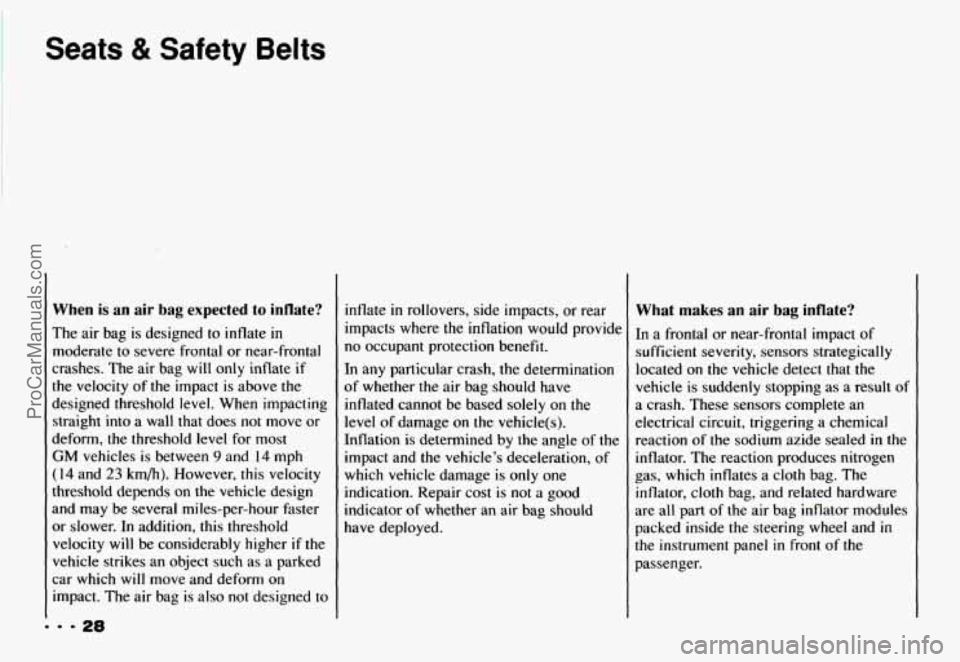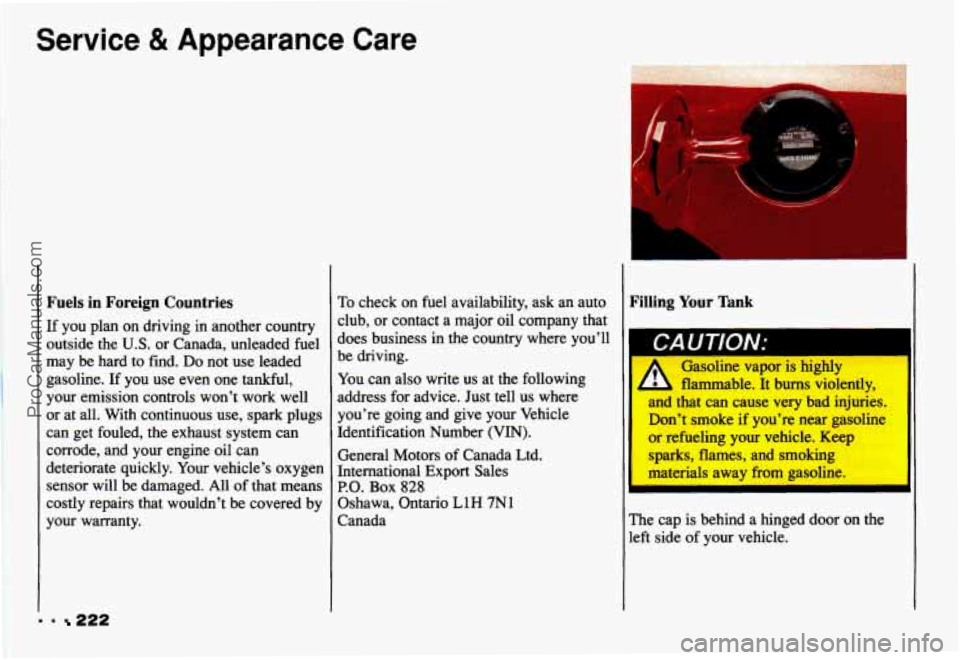Page 32 of 358

Seats & Safety Belts
When is an air bag expected to inflate?
The air bag is designed to inflate in
moderate to severe frontal or near-frontal
crashes. The air bag will only inflate
if
the velocity of the impact is above the
designed threshold level. When impacting straight into a wall that does not move or
deform, the threshold level for most
GM vehicles is between 9 and 14 mph
(14 and 23 km/h). However, this velocity
threshold depends
on the vehicle design
and may be several miles-per-hour faster
or slower. In addition, this threshold
velocity
will be considerably higher if the
vehicle strikes an object such as a parked
car which will move and deform on
impact. The air bag
is also not designed to inflate
in rollovers, side impacts, or rear
impacts where the inflation would provide
no occupant protection benefit.
In any particular crash, the determination
of whether the air bag should have
inflated cannot be based solely on the
level of damage on the vehicle(s).
Inflation is determined by the angle of the
impact and the vehicle’s deceleration, of
which vehicle damage is only one
indication. Repair cost
is not a good
indicator of whether an air bag should
have deployed.
What makes an air bag inflate?
In a frontal or near-frontal impact of
sufficient severity, sensors strategical
located on the vehicle detect that the
vehicle is suddenly stopping as a result of
a crash. These sensors complete an
electrical circuit, triggering a chemical
reaction of the sodium azide sealed
in the
inflator. The reaction produces nitrogen
gas, which inflates a cloth bag. The
inflator, cloth bag, and related hardware
are all part
of the air bag inflator modules
packed inside the steering wheel and
in
the instrument panel in front of the
passenger.
ProCarManuals.com
Page 89 of 358

Main Light Control
The main light control is a knob that
works these lights:
0 Headlights
0 Taillights
Parking lights
0 License lights
0 Sidemarker lights
Instrument panel lights
Turn the knob
to SF- to turn on your
headlights and other operating lights.
Turn
the knob to pf to turn on your
parking lights without your headlights,
Turn the knob to
OFF to turn off the
lights.
. .....
Brightness Control
This switch controls the brightness of
your instrument panel lights. Turn the switch to brighten or dim the lights.
If you
turn the switch all the way up to
dv ,
your courtesy lights will come on.
Lights On Reminder
If you turn the ignition Off and leave the
lights on, you
will hear a tone when you
open the driver’s door.
Daytime Running Lights (Canada)
The Canadian Federal Government has
decided that “Daytime Running Lights”
(DRL) are a useful feature,
in that DRL
can make your vehicle more visible to
pedestrians and other drivers during
daylight hours.
DRL are required on new
vehicles sold
in Canada.
Your DRL work
with a light sensor on top
of the instrument panel. Don’t cover
it up.
The front
turn signal lights will come on
in daylight when:
0 The ignition is on
The headlight switch is off, and
The parking brake is released.
ProCarManuals.com
Page 226 of 358

Service & Appearance Care
Fuels in Foreign Countries
If you plan on driving in another country
outside the
U.S. or Canada, unleaded fuel
may be hard to find.
Do not use leaded
gasoline.
If you use even one tankful,
your emission controls won’t work well or at all. With continuous use, spark plugs
can get fouled, the exhaust system can
corrode, and your engine oil can
deteriorate quickly.
Your vehicle’s oxygen
sensor will be damaged.
All of that means
costly repairs that wouldn’t be covered by
your warranty.
c L. 222
To check on fuel availability, ask an auto
club,
or contact a major oil company that
does business in the country where you’ll
be driving.
You can also write us at the following
address for advice. Just tell us where
you’re going and give your Vehicle
Identification Number (VIN).
General Motors of Canada Ltd.
International Export Sales
P.O. Box 828
Oshawa, Ontario L1H 7N1
Canada
I
Filling Your Tank
Gasoline vapor is highly
flammable. It burns violently,
and that can cause very bad injuries. Don’t smoke if you’re near gasoline
or refueling your vehicle. Keep
, sparks, flames, and smoking
C
materials away from gasoline.
‘I
The cap is behind a hinged door on the
left side of your vehicle.
ProCarManuals.com
Page 282 of 358
Service & Appearance Care
278
Underhood Electrical Center
Fuses
1 - Electronic Brake Control Module
(5 Amp.)
2 - Fog Lamps (20 Amp.)
3 - Not Used
4 - Not Used
5 - Anti-Lock Brake System (5 Amp.)
6 - Coolant Fan Relays; EVAP
Canister Purge Solenoid; Exhaust
Gas Recirculation; Low Coolant
Relay; Reverse Lockout Solenoid
(10 Amp.)
7 - Air Injection Pump Assembly;
8 - Not Used
9 - Fuel Injectors (7.5 Amp.)
10 - Fuel Injectors (7.5 Amp.)
11 - VIN Engine Code S: Camshaft
Air
Pump Relay
(20 Amp.)
Position Sensor; Crankshaft
Position Sensor; Electronic
Ignition Module
(10 Amp.)
VIN Engine Code P: Ignition
Coil; Ignition Coil Driver
(10 Amp.)
12 - Air Conditioning Compressor
Relay; Cruise Control Switches
and Module
(20 Amp.)
Relays
B - Air Conditioning Compressor
C - Anti-Lock Brake System
D - Primary Coolant Fan (Driver Side)
E - Air Pump
F - Secondary Coolant Fan
(Passenger Side)
G - Low Coolant
H - Fog Lamps
J - High Blower
ProCarManuals.com